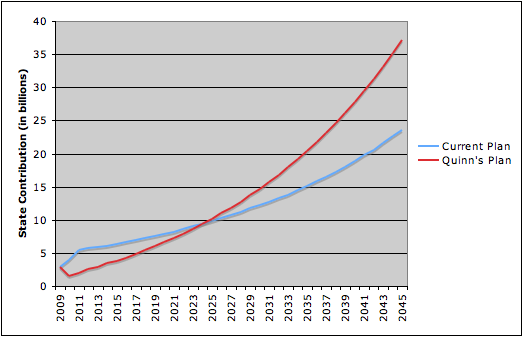Earlier this week, the AP
unearthed a document comparing the cost to
taxpayeres of Gov. Pat Quinn's pension "reform" proposal as opposed to the
current pension system. In selling his
"two-tiered" plan, Quinn and others have
emphasized that scaling back benefits for future state workers and keeping
people on the payroll longer will shrink Illinois' pension liability by $150
billion as of 2045. On its face, this sounds like it would save
taxpayers money during the alotted timeframe. But the projections
highlighted by the AP -- and
obtained by Progress Illinois -- show that
Quinn's plan would actually cost taxpayers $95 billion more over the next
36 years.
How can this be? The AP didn't really explain that part, so we'll try to do a
better job here.
It's important to remember that Quinn is using the "two-tiered" system to
justify skimming another $2.8 billion from the pension fund this year (in order
to balance the budget) and deferring half of the required $24 billion in
payments through 2013 (the habit that helped create this budget mess in the
first place). As the graph below shows, the contributions under Quinn's
plan track well below the current schedule over the next decade or so. In
2025 both systems level out, contributing about $10 billion each. Then, over the
next 20 years, Quinn's plan requires much larger infusions:

As you can see, while Quinn's system saves taxpayers $28.4 billion between 2009
and 2025, it costs them $123.1 billion more between 2026 and 2045:
Why the steep increase in state contributions? It goes back to Investing
101. Because the Quinn system scales back its contributions to the fund in
the early going, its investments are smaller and mature at a slower rate.
For instance, look at the projections as of 2025. The
current system has $125 billion worth of assets and is 51 percent funded at this
juncture. By contrast, Quinn's plan has only $52 billion worth of assets and is
22 percent funded. In order to meet the goal of a 90 percent funded ratio
by 2045, Quinn's system then requires much larger contributions to make up for
lost time. (Imagine balancing the budget in those years ...)
Based on these calculations, it's easy to see why the public employee unions are
up in arms about the rush to cut back future employee benefits. If this
fast-tracked proposal ultimately passes, we'll
hear a lot about fiscal responsibility and reining in the "gold-plated" pensions
purportedly enjoyed by retired state workers.
But while this may go over well with voters in the short term, the reality is
that taxpayers are going to end up paying more for less down the road.